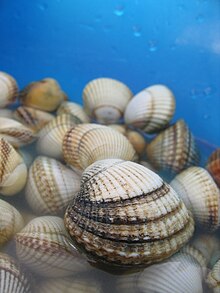
Back Сэрцападобнікі Byelorussian Сърцевидки Bulgarian Càrdids Catalan Cardiidae CEB Cocsen Welsh Herzmuscheln German Κυδώνι (ζώο) Greek Cardiidae Spanish Berberetxo Basque صدف راهراه Persian
| Cockle Temporal range:
| |
|---|---|

| |
| Live specimens of Cerastoderma edule from France | |
| Scientific classification | |
| Domain: | Eukaryota |
| Kingdom: | Animalia |
| Phylum: | Mollusca |
| Class: | Bivalvia |
| Order: | Cardiida |
| Superfamily: | Cardioidea |
| Family: | Cardiidae Lamarck, 1809 |
| Subfamilies | |
| Synonyms | |
|
Lymnocardiidae | |
A cockle is an edible marine bivalve mollusc. Although many small edible bivalves are loosely called cockles, true cockles are species in the family Cardiidae.[2]
True cockles live in sandy, sheltered beaches throughout the world. The distinctive rounded shells are bilaterally symmetrical, and are heart-shaped when viewed from the end. Numerous radial, evenly spaced ribs are a feature of the shell in most but not all genera (for an exception, see the genus Laevicardium, the egg cockles, which have very smooth shells).
The shell of a cockle is able to close completely (i.e., there is no "gap" at any point around the edge). Though the shell of a cockle may superficially resemble that of a scallop because of the ribs, cockles can be distinguished from scallops morphologically in that cockle shells lack "auricles" (triangular ear-shaped protrusions near the hinge line) and scallop shells lack a pallial sinus. Behaviorally, cockles live buried in sediment, whereas scallops either are free-living and will swim into the water column to avoid a predator, or in some cases live attached by a byssus to a substrate.
The mantle has three apertures (inhalant, exhalant, and pedal) for siphoning water and for the foot to protrude. Cockles typically burrow using the foot, and feed by filtering plankton from the surrounding water. Cockles are capable of "jumping" by bending and straightening the foot. As is the case in many bivalves, cockles display gonochorism (the sex of an individual varies according to conditions),[3] and some species reach maturity rapidly.
The common name "cockle" is also given by seafood sellers to a number of other small, edible marine bivalves which have a somewhat similar shape and sculpture, but are in other families such as the Veneridae (Venus clams) and the ark clams (Arcidae). Cockles in the family Cardiidae are sometimes referred to as "true cockles" to distinguish them from these other species.
- ^ Schneider, Jay A. (1995). "Phylogeny of the Cardiidae (Mollusca, Bivalvia): Protocardiinae, Laevicardiinae, Lahilliinae, Tulongocardiinae subfam. n. and Pleuriocardiinae subfam. n.". Zoologica Scripta. 24 (4). Wiley-Blackwell: 321–346. doi:10.1111/j.1463-6409.1995.tb00478.x. ISSN 0300-3256. S2CID 86183611.
- ^ >MolluscaBase eds. (2022). MolluscaBase. Cardiidae Lamarck, 1809. Accessed through: World Register of Marine Species on 2022-02-09
- ^ "Synthesis on biology of Common European Cockle (Cerastoderma edule" (PDF). Reservebaiedesaintbrieuc.com. Retrieved 13 October 2012.[permanent dead link]
© MMXXIII Rich X Search. We shall prevail. All rights reserved. Rich X Search